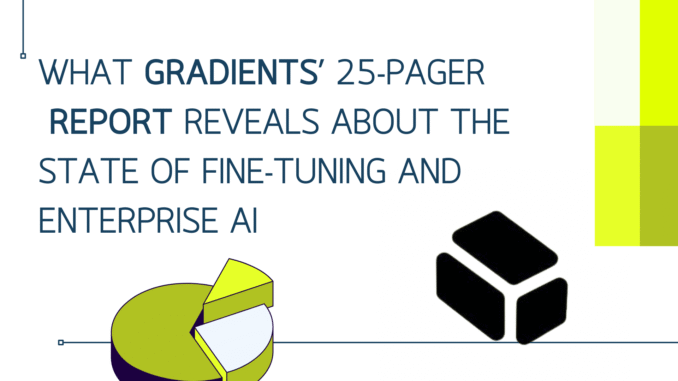
Gradients has published a detailed annual report outlining the future of enterprise fine-tuning, the limits of current AutoML systems, and Subnet 56’s progress over 11 months of continuous development.
This summary distills the most important ideas into a clear and structured overview.
The Expanding Market for Post Training
The report opens with a strong message. The fine-tuning and diffusion training market is growing rapidly and is projected to reach $12-$20 billion by 2030.
Enterprises are accelerating their AI spending, yet they continue to face the same problem. General-purpose models do not understand specialised terminology and cannot deliver reliable results inside domain-specific workflows.
Common examples include:
a. Hospitals processing clinical abbreviations
b. Energy companies analysing drilling logs
c. Financial teams working with proprietary risk frameworks
d. Legal practices handling jurisdiction-specific citations
These organisations need models that speak their internal language. This is why post-training is becoming the primary value layer in enterprise AI.
Why Enterprises Struggle at The Final Stage of AI Adoption
The report explains a pattern familiar across the industry. Companies either hire expensive machine learning experts or rely on one-size-fits-all AutoML tools.
Both paths create problems.
a. In-house teams are costly and slow
b. AutoML systems rely on generic configurations
c. Most models never reach production
d. ROI remains low across many AI initiatives
Fine-tuning becomes unreliable when data types, time budgets, and model sizes vary. A single static recipe cannot adapt to these nuances. This structural gap creates the demand for a more dynamic approach.
Subnet 56’s Tournament System as a New Form of AutoML
Gradients (Subnet 56 on Bittensor) introduces a competitive mechanism inspired by economic selection rather than fixed algorithms.
Miners submit training scripts and compete in structured tournaments. Winners advance through group rounds, knockout stages, and a final benchmark known as the boss battle.
The strongest script becomes open source and powers all customer jobs until a challenger surpasses it.
This system creates continuous evolution. Each round encourages miners to refine ideas, study prior winners, and optimize based on measurable outcomes.
Weekly iteration outpaces quarterly updates from traditional platforms.
Performance results from 180 controlled experiments include:
a. More than 80% win rate over HuggingFace AutoTrain
b. Full win rate over TogetherAI, Databricks, and Google Cloud
c. Average improvements ranging from 12%-42% depending on the task
These gains are especially strong in retrieval augmented generation and person-specific diffusion training.
A Year of Continuous Technical Progress
The report also documents an impressive 11-month execution timeline.
Key milestones include:
a. Instruction tuning at launch
b. Diffusion training added in February
c. DPO (Direct Preference Optimization) and GRPO (Group Relative Policy Optimization) support introduced in the spring
d. Open source tournaments launched in July
e. Full migration to open tournament scripts in autumn
e. Multi-job pipelines and $TAO payment support now in production
The platform has been operating throughout this period with no marketing spend, yet has already attracted early customers.
Strong Early Traction
Gradients has processed nearly 3,000 training jobs since launch. More than half of all users return for additional jobs, and a significant portion become high-volume users.
Additional highlights include:
a. Retention above 50%
b. Power users completing more than 20 jobs each
c. Most workloads involving 1-40 billion parameter models
d. Token reserves above $2 million
e. Infrastructure able to scale on demand
The technical validation is complete. The next stage focuses on commercial expansion.
A Clear Three-Phase Commercial Strategy
The report outlines a structured plan for growth. This plan is well grouped into phases:
1. Phase one
Convert startups that are hiring machine learning engineers. These teams can replace a full-time hire with a $5,000-$20,000 annual training budget.
Free consulting reduces friction and allows Gradients to demonstrate value quickly.
2. Phase two
Scale through partnerships. Integrations with Weights and Biases, LangChain, other Bittensor subnets, and cloud marketplaces.
This would place Gradients directly inside existing developer workflows.
3. Phase three
Expand into enterprise contracts. Dedicated hosting, private tournaments, compliance guarantees, and tailored support unlock higher value relationships.
Across all phases, the company relies on a Barbell Strategy. High volume startup usage provides reac,h while enterprise accounts provide concentrated recurring revenue.
The Elements that Protect the Ecosystem
The report highlights four structural advantages.
a. Deep internal expertise in preparing data and guiding customers
b. Control of the tournament ecosystem and its evolving miner network
c. Attribution rules that turn every trained model into organic marketing
d. 11 months of infrastructure development that is not easily replicated
These factors combine to create a durable lead in both performance and operational maturity.
The Remaining Gap is Commercial Leadership
The final section is direct. The technology works. The performance is proven. The next requirement is commercial expertise.
Hiring experienced sales and marketing leadership will determine how quickly the platform can scale toward the projected revenue targets.
Catch up on the full report:




Be the first to comment